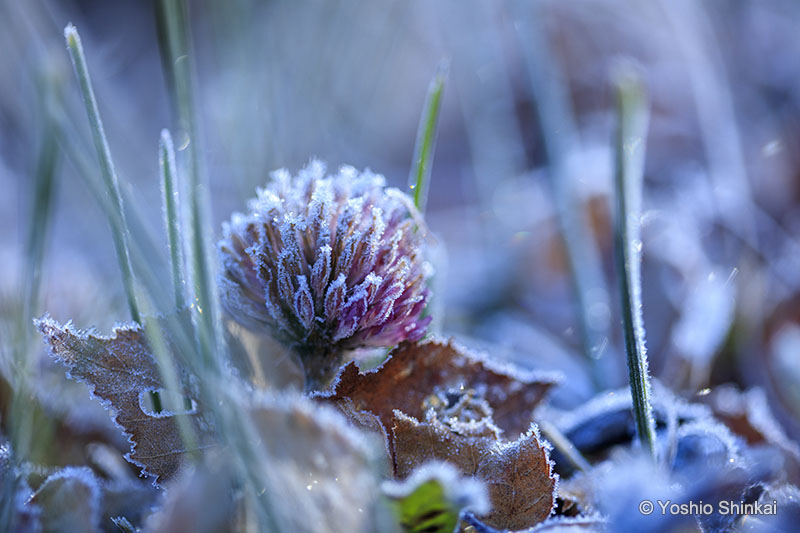Yoshio Shinkai | Markins Ball Head
Theme
Natural scenery
Photographer
Yoshio Shinkai
Date
November 2019
Location
Nagano Prefecture, Yamanashi Prefecture
Device
Markins
Canon
EOS 5DsR
EF24-70mm F4L IS USM
EF100mm F2.8 Macro USM
EF100-400mm F4.5-5.6L ISII USM
EF24-70mm F4L IS USM
EF100mm F2.8 Macro USM
EF100-400mm F4.5-5.6L ISII USM
Velbon
GEO E635M
Review
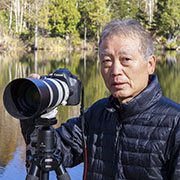
Yoshio Shinkai
Born in Nagano Prefecture in 1953.
After graduating from Chiyoda Design Photography School in 1976, worked at Photo Kosha Co., Ltd., and began taking landscape photos of various parts of Japan with a large-format camera in 1979. In 2007, also began using digital cameras, and now takes landscape photos of various parts of Japan with a digital camera. Held numerous collaborative photo exhibitions, including 12 collaborative exhibitions at Fuji Photo Salon. Held a solo exhibition, "The Four Seasons of Excitement," in Nagano Prefecture. Also held a solo exhibition, "Yoshio Shinkai Lunea Exhibition," at Gallery Daiichi in Yamaguchi City, Yamaguchi Prefecture.
Current concept is to express the "beauty of Japan" through natural light and color in the naturally rich Japanese landscapes, and provides many works for posters, calendars, photo magazines, travel magazines, and more.
After graduating from Chiyoda Design Photography School in 1976, worked at Photo Kosha Co., Ltd., and began taking landscape photos of various parts of Japan with a large-format camera in 1979. In 2007, also began using digital cameras, and now takes landscape photos of various parts of Japan with a digital camera. Held numerous collaborative photo exhibitions, including 12 collaborative exhibitions at Fuji Photo Salon. Held a solo exhibition, "The Four Seasons of Excitement," in Nagano Prefecture. Also held a solo exhibition, "Yoshio Shinkai Lunea Exhibition," at Gallery Daiichi in Yamaguchi City, Yamaguchi Prefecture.
Current concept is to express the "beauty of Japan" through natural light and color in the naturally rich Japanese landscapes, and provides many works for posters, calendars, photo magazines, travel magazines, and more.
Member of the Japan Professional Photographers Society (JPS)
Member of the Japan Landscape Photographers Association (JSPA)
Member of the Japan Landscape Photographers Association (JSPA)
I started taking landscape photos 47 years ago, quickly transitioning from a 6x6 twin-lens reflex camera to a 4x5 large format camera. This was, of course, during the era of positive film. The tripod I used at that time was large and heavy, equipped with a sturdy integrated 3-way head, which I despised carrying around due to its weight.
Back then, few photographers opted for ball heads, primarily due to concerns about their robustness. When I switched to digital cameras, I began using tripods made of lighter materials, such as carbon fiber. However, as my camera's resolution increased, so did my worries about camera shake.
Upon investigating the various causes of camera shake, I realized that the head of the tripod was likely a more significant factor than the thickness of the legs. It was around this time that I heard from an acquaintance about the effectiveness of Markins heads in minimizing camera shake.

When you try it, you'll be surprised at how easy it is to use. With the L-plate, you can fix the camera body with one touch, and if you set the camera horizontally with the fixing knob, you can immediately move on to focusing and composing, so the time to shoot is short and very smooth.
Encountering nature is an important element in landscape photography, so being able to set up the camera smoothly has the advantage of not missing an opportunity.
Landscape photography often requires walking long distances. The weight of the tripod is very important, especially when walking in the mountains. If it is light, durable, and easy to use, it will be fun to carry the tripod around.
Moreover, the most important thing is that the subject you want to shoot can be expressed without camera shake.
Markins' ball head Q10i-BK has now become an essential item that you can use with confidence.
Encountering nature is an important element in landscape photography, so being able to set up the camera smoothly has the advantage of not missing an opportunity.
Landscape photography often requires walking long distances. The weight of the tripod is very important, especially when walking in the mountains. If it is light, durable, and easy to use, it will be fun to carry the tripod around.
Moreover, the most important thing is that the subject you want to shoot can be expressed without camera shake.
Markins' ball head Q10i-BK has now become an essential item that you can use with confidence.

■ Morning mist at Kido Pond
Canon EOS 5DsR / EF24-70mm F4L IS USM1/13 s F11 ISO-100
It was late autumn at Kido Pond in Shiga Kogen. The larch trees had not yet lost their leaves, so I waited for the sunlight to shine in, hoping that the morning sun would shine in and create a contrast with the orange color of the trees.
When the sun peeks out from behind the mountains, mist flows over the surface of Kido Pond, and the mist and yellow larch leaves floating on the still water are mystical. The framing also changes depending on the light, so the ball head adapts well to even slight changes in the angle of view, such as when you don't want to include a certain tree, so there is no stress. At this time, it was important to make fine adjustments by tilting it left and right.
When the sun peeks out from behind the mountains, mist flows over the surface of Kido Pond, and the mist and yellow larch leaves floating on the still water are mystical. The framing also changes depending on the light, so the ball head adapts well to even slight changes in the angle of view, such as when you don't want to include a certain tree, so there is no stress. At this time, it was important to make fine adjustments by tilting it left and right.
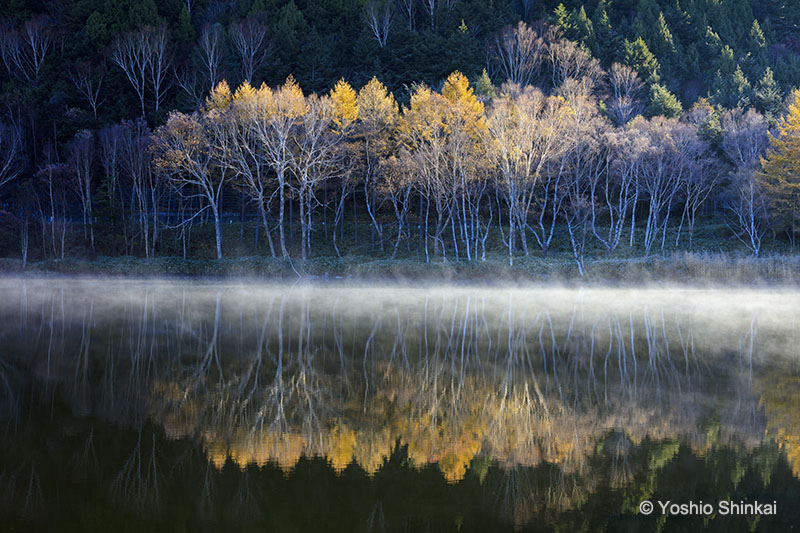
■ Spawning of the autumn darter
Canon EOS 5DsR / EF100-400mm F4.5-5.6L ISII USM1/4000 s F5.6 ISO-500
Water had accumulated in the rice fields after the rice harvest, and the regenerated rice plants, called "hitsuji," were shining green.
Among them, pairs of autumn darters flew around, approaching the water's surface and dipping their tails in the water. I later learned that this is a method of spawning called "linked mud spawning."
I tried to take a photo with my telephoto zoom lens, but the dragonfly was moving so quickly that I couldn't get it in focus. I couldn't do it with autofocus, and I couldn't even focus on it, and no matter how many times I tried, it was difficult. The ball head helped me by switching to manual focus while instantly adjusting the subtle focus shift.
By loosening the fixing knob of the ball head a little and going freehand, I was able to endure a long time while following the dragonfly and fine-tuning the focus, and I was able to take several photos in focus.
Among them, pairs of autumn darters flew around, approaching the water's surface and dipping their tails in the water. I later learned that this is a method of spawning called "linked mud spawning."
I tried to take a photo with my telephoto zoom lens, but the dragonfly was moving so quickly that I couldn't get it in focus. I couldn't do it with autofocus, and I couldn't even focus on it, and no matter how many times I tried, it was difficult. The ball head helped me by switching to manual focus while instantly adjusting the subtle focus shift.
By loosening the fixing knob of the ball head a little and going freehand, I was able to endure a long time while following the dragonfly and fine-tuning the focus, and I was able to take several photos in focus.
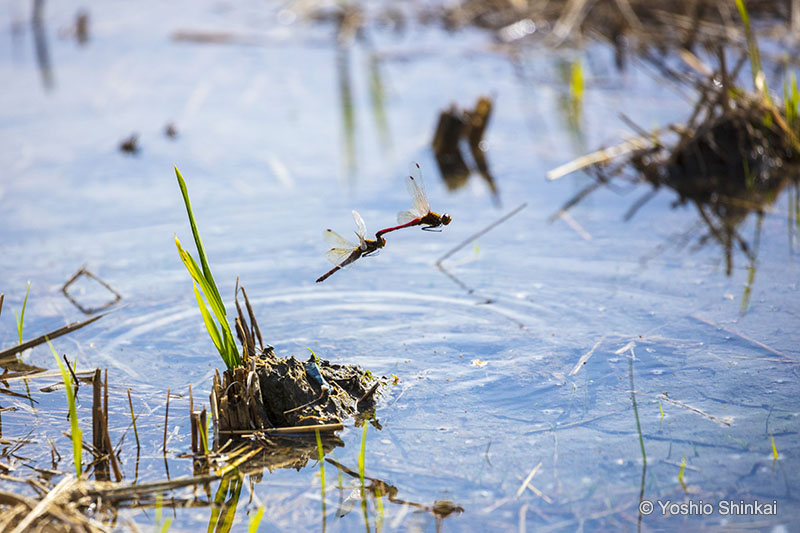
■ Mt. Fuji in the Morning
Canon EOS 5DsR / EF100-400mm F4.5-5.6L ISII USM1/200 s F8 ISO-100
I was impressed by the sea of clouds and morning mist over Mt. Fuji, which reminded me of a Japanese painting.
When photographing Mt. Fuji, it is surprisingly important that the camera is level.
If the camera is tilted, Mt. Fuji will look unnatural and you will not be able to see it stably. If you shoot handheld, it is a subject that you will regret later.
You need to be especially careful with long-focus zoom lenses. The Markins ball head Q10i-BK that I used does not move once you tighten the fixing knob, and it is extremely stable. I felt that it was thanks to the ball head that I was able to shoot without camera shake, even though it was a medium-sized tripod.
When photographing Mt. Fuji, it is surprisingly important that the camera is level.
If the camera is tilted, Mt. Fuji will look unnatural and you will not be able to see it stably. If you shoot handheld, it is a subject that you will regret later.
You need to be especially careful with long-focus zoom lenses. The Markins ball head Q10i-BK that I used does not move once you tighten the fixing knob, and it is extremely stable. I felt that it was thanks to the ball head that I was able to shoot without camera shake, even though it was a medium-sized tripod.
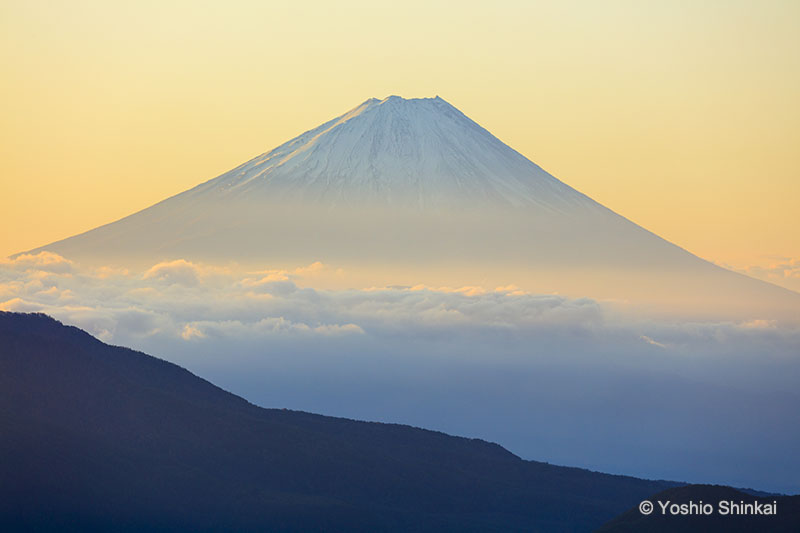
■ Frost Morning
Canon EOS 5DsR / EF100mm F2.8 Macro USM1/320 s F2.8 ISO-200
Before sunrise, when the morning glow was spreading, it was -5°C. It was cold and there was no wind, so the grass was covered in white frost. At times like this, I wanted to use a macro lens for precise depiction.
I opened the tripod to its maximum and started shooting. A ball head allows for free and easy framing.
I opened the aperture to blur the background, and focused on the plant as the focal point for precise depiction.
The sunless, pale-white atmosphere gives a sense of coldness, and even conveys the atmosphere of the surroundings.
When taking into account fine details such as the sense of depth seen in the background with bokeh, it is best to use a tripod.
I opened the tripod to its maximum and started shooting. A ball head allows for free and easy framing.
I opened the aperture to blur the background, and focused on the plant as the focal point for precise depiction.
The sunless, pale-white atmosphere gives a sense of coldness, and even conveys the atmosphere of the surroundings.
When taking into account fine details such as the sense of depth seen in the background with bokeh, it is best to use a tripod.
